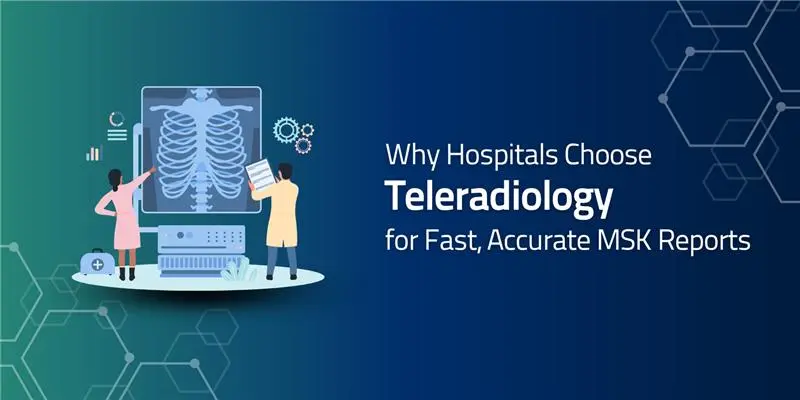

Teleradiology
Why Hospitals Prefer Teleradiology Outsourcing for Accurate and Timely MSK Injury Reports
Introduction
Anterior cruciate ligament (ACL) injuries are among the most common musculoskeletal (MSK) problems, particularly in athletes and active adults. They can occur during sports that involve sudden stops, twists, or pivots like football, basketball, or skiing. However, they’re not limited to athletes; anyone can sustain an ACL tear after a fall or trauma.
Delays in reporting can postpone surgery, rehabilitation, and return to activity. That’s why many hospitals are now adopting teleradiology outsourcing a model that connects them instantly to expert MSK radiologists across the globe for faster, more reliable MRI interpretations.
The Growing Challenge: Rising ACL Injuries and Diagnostic Delays
ACL injuries are on the rise worldwide. The incidence of ACL tears has nearly doubled over the last two decades due to increased sports participation and better detection.
Yet, radiology departments often struggle with limited staff, heavy caseloads, and after-hours backlogs. These factors extend turnaround time (TAT) for MRI reports impacting both clinical decisions and patient outcomes.
When MRI results are delayed, treatment initiation slows, surgical planning is postponed, and rehabilitation protocols are disrupted. For hospitals, this leads to workflow inefficiency and patient dissatisfaction.
Teleradiology outsourcing directly addresses these pain points by providing 24/7 access to subspecialty radiologists who can deliver high-quality MSK reports promptly.
Understanding Teleradiology Outsourcing
Teleradiology outsourcing refers to the practice of transmitting medical images such as X-rays, CT scans, or MRIs to radiologists located off-site for interpretation.
Through secure digital platforms, hospitals can share scans instantly with certified radiologists who provide accurate reports remotely. This model:
- Eliminates geographical limitations.
- Reduces dependency on in-house night shifts.
- Ensures continuous coverage, even during weekends or holidays.
It bridges the gap between hospitals and subspecialty experts, allowing clinicians to access high-quality diagnostic opinions whenever needed.
MRI: The Gold Standard for ACL Injury Diagnosis
While X-rays and ultrasounds help in initial assessment, MRI remains the gold standard for diagnosing ACL injuries. It provides detailed visualization of soft tissues, ligaments, and cartilage that other modalities cannot capture.
Typical MRI findings in ACL tears include:
- Discontinuity or abnormal signal of the ACL fiber bundle.
- Bone bruising on the lateral femoral condyle and tibial plateau.
- Joint effusion and associated meniscal tears.
MRI also helps detect secondary MSK injuries such as cartilage damage or collateral ligament strain ensuring comprehensive evaluation before surgery or rehabilitation.
Accelerating ACL MRI Reporting Through Teleradiology
Teleradiology revolutionizes the reporting workflow by routing digital MRI images directly from hospital PACS systems to remote MSK radiologists.
Here’s how it works:
- The hospital uploads the MRI to a secure cloud platform.
- A specialized MSK radiologist reviews the scan remotely.
- A verified, detailed report is sent back often within hours.
This eliminates bottlenecks and ensures around-the-clock reporting.
Benefits include:
- Subspeciality interpretation by MSK radiologists experienced in sports injuries.
- Real-time collaboration between clinicians and radiologists.
- Consistent report formats with peer-reviewed accuracy.
Hospitals using teleradiology outsourcing often see TAT improvements of 40–60%, enabling faster clinical decisions and smoother patient management.
Key Benefits for Hospitals and Orthopedic Centres
Faster Report Delivery and Improved Case Throughput
Radiology backlogs are minimized, ensuring immediate access to imaging results critical for pre-surgical planning and emergency cases.
Cost-Efficiency and Staffing Flexibility
Hospitals reduce the need for full-time overnight radiologists while maintaining uninterrupted services.
Access to Global MSK Specialists
Through outsourcing, hospitals connect with radiologists who specialize exclusively in musculoskeletal imaging—enhancing accuracy and confidence in diagnosis.
Support for Emergency and After-Hours Cases
Night-time sports injuries or trauma cases no longer face reporting delays. Teleradiology ensures expert reads at any hour.
Excellence in MSK Reporting: AMI’s Approach
At Aster Medical Imaging (AMI), excellence in musculoskeletal and body imaging lies at the core of our teleradiology ecosystem. Our Musculoskeletal Radiology and Body Imaging services combine human expertise with advanced digital tools to ensure precision, speed, and reliability.
Our differentiators include:
- Subspecialty Expertise: Each MRI is reviewed by radiologists trained in MSK imaging, including ACL, meniscal, and cartilage pathology.
- Double-Read Quality Assurance: All critical cases undergo a secondary review for accuracy.
- AI-Enabled Prioritization: Urgent or emergency cases are automatically flagged for faster turnaround.
- Secure Integration: Seamless connectivity with hospital PACS and strict adherence to data-privacy regulations.
The Future of Orthopedic Imaging and Teleradiology
The future of MSK imaging is being shaped by AI, automation, and cross-border collaboration.
Key trends include:
- AI-Assisted Detection: Algorithms that pre-analyze MRIs for ligament tears or meniscal injuries, helping radiologists prioritize cases.
- Cloud-Based Collaboration: Secure sharing platforms enabling joint reviews between orthopedic surgeons and radiologists.
- Expanded Applications: Teleradiology is now supporting diagnosis of rotator cuff injuries, meniscal tears, and chronic overuse syndromes—far beyond ACL pathology.
Conclusion
ACL injuries require precise diagnosis and rapid turnaround for successful treatment. Teleradiology outsourcing empowers hospitals to meet these demands efficiently offering immediate access to subspecialty MSK radiologists and faster reporting times.
By partnering with experts like Aster Medical Imaging, hospitals gain not only speed but also diagnostic excellence and data security ensuring every patient receives accurate, timely care.
Key Takeaways
- Teleradiology outsourcing delivers faster, expert-led MRI reporting for ACL and other MSK injuries.
- Hospitals benefit from reduced turnaround time, lower costs, and 24/7 specialist access.
- AMI’s Musculoskeletal and Body Imaging services ensure peer-reviewed accuracy, seamless integration, and AI-assisted efficiency.
- The future of orthopedic imaging lies in combining human expertise with intelligent teleradiology solutions.
FAQs
MRI is the gold standard because it visualizes soft tissues in high detail, allowing accurate assessment of ligament tears and associated injuries.
Patients often describe a “pop” at the time of injury, followed by swelling, instability, and pain when pivoting or walking.
Yes. An untreated ACL tear can lead to knee instability, meniscal damage, and early-onset osteoarthritis, making early imaging and diagnosis essential.
More from AMI
Sports-Related Injuries and the Importance of Radiology
30/01/2023
Radiology Online Reporting: Transforming Diagnosis with Speed and Accuracy
31/07/2025
Imaging In Pregnancy
18/01/2023
The Future of MRI: Advancements and AI Integration in Online MRI Reporting
19/05/2025
How to Choose a Prospective Teleradiology Service Provider
07/08/2023
What is Diagnostic Radiology? Understanding its Tests and Procedures
14/08/2023
Advances In Neuroradiology
06/01/2023
How Aster Medical Imaging’s Nighthawk Service Enhances Brain Neuroimaging
29/09/2025
Scope of Radiologist in India
29/08/2023
Empowering Radiologists-Teleradiology Redefines the Role of Imaging Specialist
09/10/2023
Teleradiology's Contribution to Timely Emergency Diagnoses
04/10/2023
How Teleradiology Solutions Help Hospitals Cut Turnaround Time
20/08/2025
Radiology Practices
30/11/2022
10 Strategies To Prevent Burnout In Radiology
09/01/2023
How to Increase the Efficiency of the Radiology Equipment
21/08/2023
Behind The Scenes of Teleradiology: How Digital Imaging Is Changing Diagnostic Medicine
16/10/2023
How Teleradiology Supports Musculoskeletal Pain Specialists in Diagnosis
20/08/2025
Emerging Trends and Technologies in Medical Imaging
19/06/2023
Intra- Operative 3D Imaging With O- Arm Making Complex Spine Surgeries Safe and Accurate
30/11/2022
Imaging Instrumentation Trends In Clinical Oncology
26/06/2023
Revolutionizing Indian Healthcare: Unlocking the Potential of Teleradiology in Remote Areas
27/09/2023
Cardiovascular Imaging: Expanding Access to Advanced Heart Care with Teleradiology
29/09/2025
MRI Spine Thoracic: How Teleradiology Enhances Faster, Accurate Diagnosis
29/09/2025
Emerging Techniques in Radiology By Dr. Namita
10/11/2022
Improvement of Patient Care Through Teleradiology
03/07/2023

AMI Expertise - When You Need It, Where You Need It.
Partner With Us
